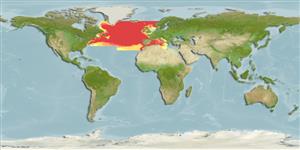Environment: milieu / climate zone / depth range / distribution range
Ecologia
marino batipelagico; oceanodromo; distribuzione batimetrica 50 - 1032 m (Ref. 56504), usually 200 - 600 m (Ref. 35388). Deep-water; 65°N - 30°N, 77°W - 21°E
Atlantic Ocean: restricted to the North Atlantic and adjacent seas.
Size / Peso / Age
Maturity: Lm ? range ? - ? cm
Max length : 50.0 cm SL maschio/sesso non determinato; (Ref. 35388)
Depth range from 50-1000 m (ref. 04473) and up to 1032 m in the eastern Ionian Sea (Ref. 56504). Epipelagic to bathypelagic (Ref. 58426); also mesopelagic (Ref. 5951). Feeds on fishes, crustaceans and occasionally planktonic organisms (Ref. 5759). Spawns from March to September, larvae near the surface (Ref. 35388).
Life cycle and mating behavior
Maturità | Riproduzione | Deposizione | Uova | Fecundity | Larve
Larvae are found near the surface.
Post, A., 1990. Paralepididae. p. 373-384. In J.C. Quero, J.C. Hureau, C. Karrer, A. Post and L. Saldanha (eds.) Check-list of the fishes of the eastern tropical Atlantic (CLOFETA). JNICT, Lisbon; SEI, Paris; and UNESCO, Paris. Vol. 1. (Ref. 4473)
IUCN Red List Status (Ref. 130435: Version 2024-2)
Threat to humans
Harmless
Human uses
Pesca: di nessun interesse
Strumenti
Special reports
Download XML
Fonti Internet
Estimates based on models
Preferred temperature (Ref.
123201): 2.2 - 14, mean 7.4 °C (based on 462 cells).
Phylogenetic diversity index (Ref.
82804): PD
50 = 0.5625 [Uniqueness, from 0.5 = low to 2.0 = high].
Bayesian length-weight: a=0.00224 (0.00090 - 0.00555), b=3.14 (2.92 - 3.36), in cm total length, based on LWR estimates for this (Sub)family-body shape (Ref.
93245).
Trophic level (Ref.
69278): 4.1 ±0.70 se; based on food items.
Resilienza (Ref.
120179): Medio, tempo minimo di raddoppiamento della popolazione 1.4 - 4.4 anni (Preliminary K or Fecundity.).
Fishing Vulnerability (Ref.
59153): Moderate vulnerability (44 of 100).
Nutrients (Ref.
124155): Calcium = 30.6 [9.3, 91.7] mg/100g; Iron = 0.35 [0.11, 1.10] mg/100g; Protein = 16.2 [13.1, 18.8] %; Omega3 = 0.105 [0.028, 0.323] g/100g; Selenium = 21.1 [6.3, 65.8] μg/100g; VitaminA = 11.8 [1.2, 92.8] μg/100g; Zinc = 0.442 [0.227, 0.867] mg/100g (wet weight);
